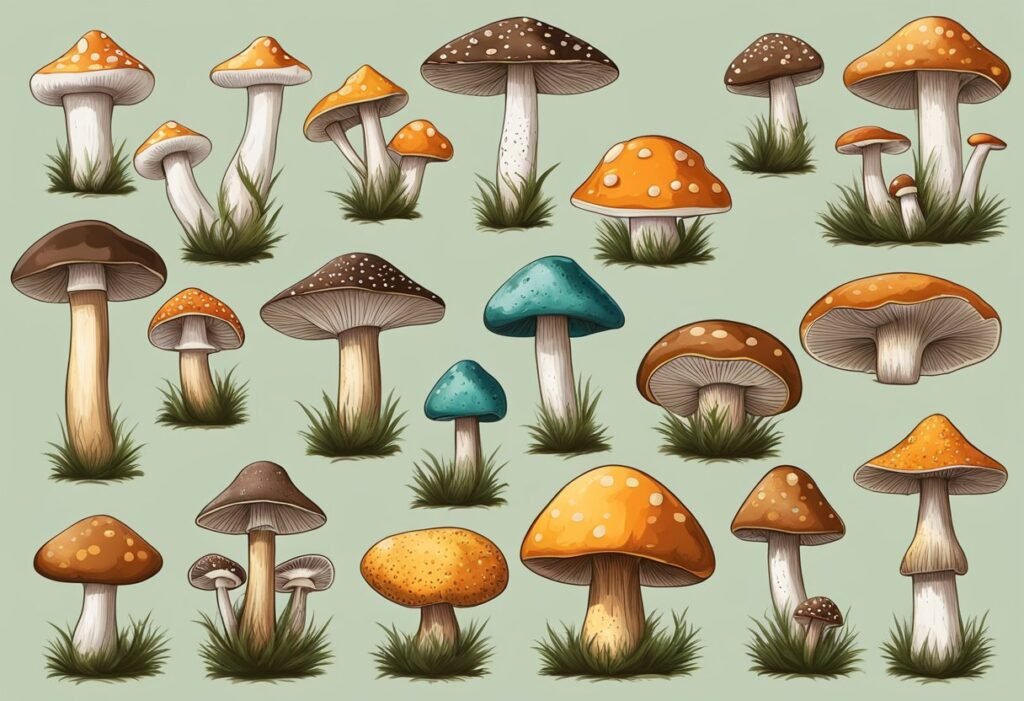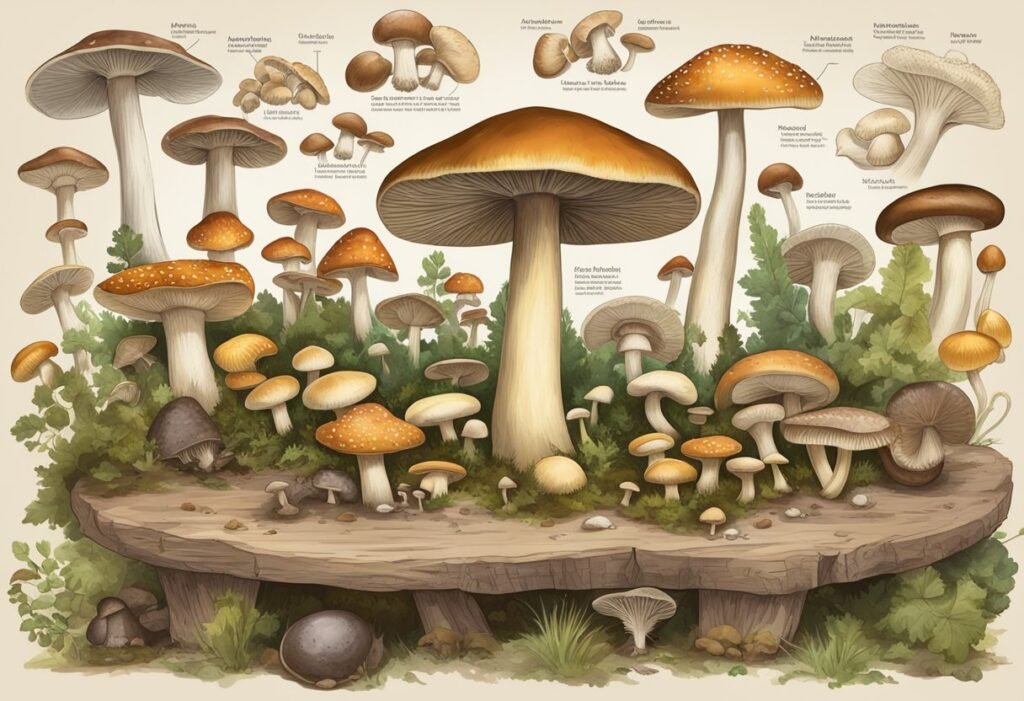Mushrooms are a popular ingredient in many dishes, but not all mushrooms are safe to eat. Some mushrooms contain toxins that can cause serious health problems or even death. Therefore, it’s important to know which mushrooms are safe to eat and which ones should be avoided.
One type of mushroom that should be avoided is the death cap mushroom. It is one of the deadliest mushrooms in the world and can cause liver failure and death if ingested. Another dangerous mushroom is the destroying angel mushroom, which can cause severe gastrointestinal distress and lead to liver and kidney failure.
It’s also important to note that some people may be allergic to certain types of mushrooms, and should avoid them to prevent an allergic reaction. Additionally, some mushrooms may interact with certain medications, so it’s important to consult a healthcare provider before consuming mushrooms if you are taking any medications.
Toxic Mushrooms Overview

Mushrooms can be a delicious addition to many dishes, but some species can be toxic and even deadly if consumed. It is important to know which mushrooms are safe to eat and which ones should be avoided. In this section, we will provide an overview of toxic mushrooms, including common species and their toxicity symptoms.
Common Toxic Species
Some of the most common toxic mushrooms include the following:
- Amanita phalloides: Also known as the death cap, this mushroom is responsible for the majority of fatal mushroom poisonings worldwide. It contains amatoxins, which can cause liver and kidney failure.
- Galerina marginata: This mushroom contains the same amatoxins as the death cap and can cause similar symptoms.
- Gyromitra esculenta: Also known as the false morel, this mushroom contains a toxin called gyromitrin, which can cause seizures and other neurological symptoms.
- Amanita muscaria: This mushroom contains ibotenic acid and muscimol, which can cause hallucinations and other psychoactive effects.
Toxicity Symptoms
The symptoms of mushroom poisoning can vary depending on the species of mushroom and the amount consumed. Some common symptoms include the following:
- Nausea and vomiting
- Abdominal pain
- Diarrhea
- Dizziness
- Confusion
- Seizures
- Liver and kidney failure
If you suspect that you or someone you know has consumed a toxic mushroom, seek medical attention immediately. It is important to provide as much information as possible about the mushroom, including its appearance and where it was found.
Identification Tips

Mushroom Anatomy
To identify mushrooms that should not be eaten, it is important to have a basic understanding of their anatomy. Mushrooms have a cap, stem, and gills or pores on the underside of the cap. The cap can be smooth or textured, and the stem can be thick or thin. The gills or pores are where the spores are produced and are used to help identify the species of mushroom.
Some mushrooms have distinctive characteristics that can help with identification. For example, the Death Cap mushroom has a greenish-yellow cap and a white stem with a skirt-like ring. The Destroying Angel mushroom has a white cap and stem with a bulbous base and a ring on the stem.
Habitat Considerations
Mushrooms can be found in a variety of habitats, including forests, fields, and even lawns. However, not all mushrooms found in these habitats are safe to eat. It is important to consider the habitat when identifying mushrooms.
For example, the Amanita phalloides, also known as the Death Cap mushroom, is commonly found in oak and beech forests. The Gyromitra esculenta, also known as the False Morel, is found in coniferous and deciduous forests. These mushrooms should not be eaten, even though they may be found in areas where edible mushrooms grow.
It is also important to consider the time of year when identifying mushrooms. Some mushrooms are only found during certain seasons, while others can be found year-round. For example, the Amanita muscaria, also known as the Fly Agaric, is commonly found in the fall.
By understanding the anatomy and habitat of mushrooms, it is possible to identify which mushrooms should not be eaten. It is important to always be cautious when foraging for mushrooms and to never eat a mushroom unless it has been positively identified as safe to eat.
Avoidance Strategies
Foraging Best Practices
Foraging for wild mushrooms can be a fun and rewarding activity, but it is important to exercise caution when doing so. The following are some best practices to follow when foraging for mushrooms:
- Always go with an experienced forager or a guide who is knowledgeable about mushroom identification.
- Learn to identify the most common poisonous mushrooms in your area and avoid them.
- Stick to well-known and well-traveled areas when foraging for mushrooms.
- Avoid foraging in areas that have been sprayed with pesticides or other chemicals.
- Do not eat mushrooms that have been damaged or are showing signs of decay.
Culinary Precautions
Even if you have correctly identified a mushroom as safe to eat, there are still some precautions you should take when preparing and cooking them:
- Always cook mushrooms thoroughly before eating them. This will help to break down any toxins that may be present and make them safe to consume.
- Do not eat raw mushrooms, as some species contain toxins that can cause gastrointestinal distress.
- If you are unsure about the edibility of a mushroom, it is best to err on the side of caution and avoid eating it.
- Do not mix different species of mushrooms together when cooking, as this can make it difficult to identify any poisonous mushrooms that may be present.
- When trying a new species of mushroom for the first time, it is best to eat only a small amount to see how your body reacts to it. If you experience any adverse effects, seek medical attention immediately.
By following these avoidance strategies, foragers can reduce their risk of consuming poisonous mushrooms and enjoy the benefits of this rewarding activity.
Emergency Response
First Aid Measures
If someone has eaten a poisonous mushroom, it is essential to act fast. The following are some first aid measures that should be taken:
- Call emergency services or Poison Control Center immediately.
- If the person is conscious, try to make them vomit. However, do not induce vomiting if the person is unconscious, convulsing, or having difficulty breathing.
- Rinse the person’s mouth with water and give them plenty of water to drink.
- If the person is experiencing symptoms like abdominal pain, cramping, vomiting, diarrhea, or dizziness, lay them down and keep them calm.
Medical Treatment
Medical treatment for mushroom poisoning depends on the type of mushroom consumed and the severity of the symptoms. The following are some medical treatments that may be given:
- Activated charcoal may be given to absorb the toxins in the stomach.
- Intravenous fluids may be given to prevent dehydration and flush out the toxins.
- Medications may be given to manage symptoms like nausea, vomiting, and diarrhea.
- In severe cases, hospitalization may be required, and the person may need intensive care, including respiratory support and dialysis.
It is crucial to remember that mushroom poisoning can be life-threatening and should be treated as a medical emergency. If you suspect that someone has eaten a poisonous mushroom, do not wait for symptoms to appear before seeking medical help.
Further Resources
Guidebooks and Apps
For those interested in foraging wild mushrooms, there are several guidebooks and apps available that can be helpful in identifying edible mushrooms. It is important to note that foraging should only be done by experienced individuals, as many wild mushrooms are toxic and can be deadly if consumed.
One popular guidebook is “Mushrooms Demystified” by David Arora, which provides detailed information on over 2,000 species of mushrooms. The book includes illustrations and descriptions to help with identification, as well as information on edibility and cooking methods.
Another useful resource is the “Mushroom Identification App” by Mushroom Observer, which allows users to upload photos of mushrooms and receive identification assistance from a community of experts. The app also includes a database of over 150,000 mushroom observations and a map of mushroom sightings around the world.
Expert Consultations
For those who are unsure about the edibility of a particular mushroom, it is recommended to consult with an expert before consuming it. This can include mycologists, mushroom hunters, or other experienced individuals who are knowledgeable about mushroom identification and edibility.
One reputable organization is the North American Mycological Association (NAMA), which provides resources and information on mushroom identification and safety. NAMA also hosts annual forays and events for mushroom enthusiasts to learn from experts and connect with other mushroom hunters.
It is important to remember that consuming wild mushrooms can be dangerous, and it is always better to err on the side of caution. When in doubt, it is best to consult with an expert or stick to commercially available mushrooms from a trusted source.




